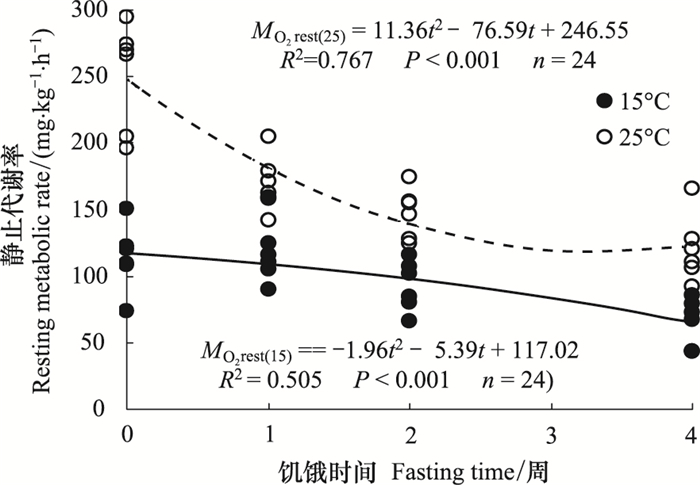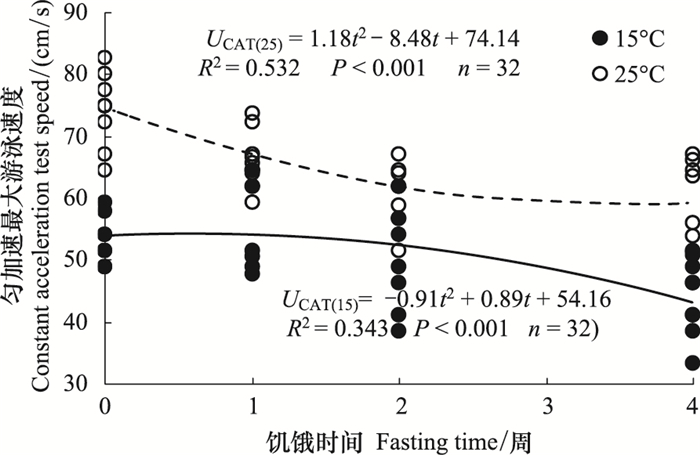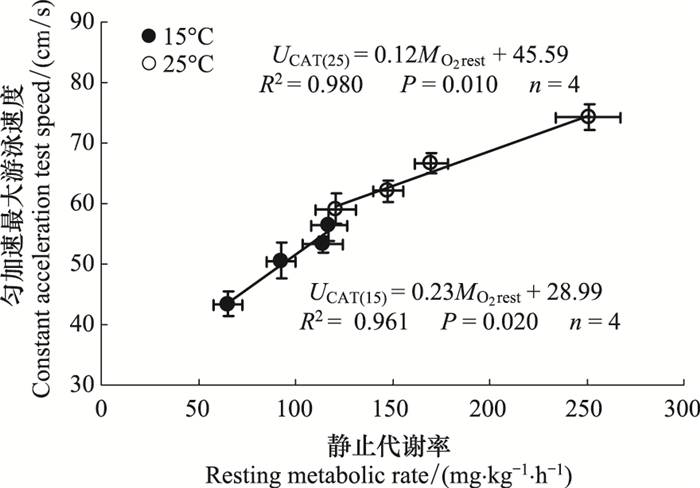文章信息
- 庞旭, 付世建, 曹振东, 张耀光
- PANG Xu, FU Shijian, CAO Zhendong, ZHANG Yaoguang
- 饥饿和温度驯化对中华倒刺鲃静止代谢和游泳能力的影响
- The effects of fasting andacclimation temperature on the resting metabolism and swimming performance in qingbo (Spinibarbus sinensis)
- 生态学报, 2016, 36(7): 1854-1860
- Acta Ecologica Sinica, 2016, 36(7): 1854-1860
- http://dx.doi.org/10.5846/stxb201409281918
-
文章历史
- 收稿日期: 2014-09-28
- 网络出版日期: 2015-04-16
2. 重庆师范大学进化生理与行为学实验室, 动物生物学重庆市市级重点实验室, 重庆 401331
2. Laboratory of Evolutionary Physiology and Behaviour, Chongqing Key Laboratory of Animal Biology, Chongqing Normal University, Chongqing 401331, China
由于自然界中食物空间分布的异质性、季节更替及环境剧变等原因,鱼类经常会面临食物资源的缺乏而遭受不同程度的饥饿胁迫[1]。鱼类遭受长期饥饿后,能量储存下降会诱导其下调机体维持能量消耗,诸多生理功能随之受到削弱[2, 3, 4]。静止代谢率(Resting metabolic rate,MO2rest)指鱼类在安静、禁食状态下的代谢能量消耗,在一定程度上反映鱼类的维持能量消耗和整体生理状况。已有研究发现,长期饥饿会导致鱼类静止代谢、食物消化及游泳运动能力均显著下降[5];然而,短期饥饿对鱼类上述生理功能的影响尚存争论[6, 7, 8]。温度作为最重要的环境因子之一,对水生变温动物生长、代谢及游泳等生理功能均有深刻影响[3, 9, 10]。在一定温度范围内,随温度升高鱼类生长加快,代谢升高,游泳运动能力增强[10]。
由于水环境特殊的理化性质,游泳运动是鱼类的逃逸、捕食和繁殖等行为实现的主要方式,为鱼类的生存、生长和繁衍提供基本保证[9, 10, 11]。因此,鱼类游泳运动是其重要的生理活动和生存适合度指标。就代谢类型而言,评判鱼类游泳运动能力的指标主要有临界游泳速度(Critical swimming speed,Ucrit)和匀加速最大游泳速度(Constant acceleration test speed,UCAT)。一般认为,Ucrit 受鱼类心鳃系统呼吸能力的限制,主要反映鱼类的有氧运动能力,与鱼类的洄游紧密相关;UCAT是指在测试水流均匀加速的条件下,鱼类能够到达的最大游泳速度,其主要反映鱼类的无氧游泳运动能力,在捕食和逃逸方面具有重要的生态学意义[11, 12]。近年来,UCAT在鱼类生理生态学、功能生态学等领域倍受研究者关注[11, 12, 13, 14]。
中华倒刺鲃(Spinibarbus sinensis)主要分布于我国长江上游及其支流,是营底栖生活,偏好流水生境,主要以水生高等植物为食的杂食性鲤科鱼类[15]。其栖息地环境温度具有较大的季节性波动,进而引起鱼类食物资源的变化;同时温度变化也会影响鱼类的游泳运动能力。因此,中华倒刺鲃的捕食与反捕食压力在不同温度条件下不尽相同。本研究以中华倒刺鲃为研究对象,在不同温度(15、25 ℃,即栖息地冬季和夏季的平均温度)条件下,分别经不同饥饿时间(0、1、2、4 周)处理后,测定其MO2rest和UCAT;本研究目标是考察中华倒刺鲃在不同温度下饥饿时间对其维持能量消耗和游泳运动能力的影响,并比较其不同温度间的差异,旨在探讨鱼类在不同温度下遭受饥饿后能量利用和游泳响应的生理生态适应对策。
1 材料与方法 1.1 实验鱼的驯化与处理实验用中华倒刺鲃幼鱼购于重庆合川水产养殖场,购回后在自净化循环控温水槽中驯养两周,水温为(20±0.5)℃。驯养期间每天在8:00以商品饲料作饵料饱足投喂1 次,投喂1 h后用虹吸管清除残饵和粪便;驯养用水为经曝气控温后的自来水,并用充气泵向水体中持续充入空气以保证水体溶氧在7 mg/L以上,水体中氨氮浓度控制在0.025 mg/L以内。日换水量约为水体总量的10%,昼夜光周期为L∶D=12h∶12h。经过2周的驯养后,将实验鱼随机分为两组;然后以每天1 ℃的变温速率将两组的温度分别调整到相应的驯化温度(15、25 ℃)。当温度到达设置驯化温度后,再经过为期3 周的温度驯化处理。当3 周的温度驯化完成后,两个温度驯化组实验鱼分别进行不同时间周期(0、1、2、4 周)的饥饿处理。为了消除摄食对实验鱼静止代谢和游泳能力的影响,0 周(对照)饥饿处理组实验鱼在进行实验之前禁食约24 h[10];其他周期饥饿处理实验鱼禁食时间均分别累加1d。温度驯化和饥饿处理期间,其他养殖条件与前两周养殖条件保持一致。
1.2 静止代谢率的测定测定耗氧量采用流水式呼吸仪[16]。测定前将实验鱼移入管状呼吸室(直径3 cm,容积120 mL),待其在呼吸室内适应12 h后测定其耗氧率;整个实验操作过程水温与驯化时水温保持一致。各呼吸室流速为30—40 mL/min,分别用溶氧仪(HQ20,Hach Company,Loveland,CO,USA)于9:00、15:00、21:00 3 次测定溶氧值和水流速度。每尾实验鱼耗氧率(mg kg-1 h-1)由以下公式进行计算:
MO2=ΔO2×v/m
式中,MO2为每尾鱼单位体重耗氧率,ΔO2 为实验呼吸室和对照呼吸室(没有鱼)溶氧的差值(mg/L),v为呼吸室的流量(L/h),通过测定出水口在1 min内流出的水量,计算其水体流速,m为每尾验鱼的体重(kg)。将3次测定耗氧率的结果经计算平均值后作为每尾鱼的静止代谢率(MO2rest)参数。
1.3 匀加速最大游泳速度的测定UCAT测定的设备为经改进后的鱼类游泳代谢测定仪,该装置的主要原理和结构详见文献[17];主要改进之处为调节流速的方式改变为通过智能化调节输出电源的频率而改变电机的转速。具体操作如下:将实验鱼转入游泳代谢测定仪中驯化适应1 h(流速为6 cm/s);驯化结束后,将测定仪中的水流速度以0.167 cm/s2 (即10 cm s-1 min-1)的加速度持续均匀增加;实验鱼力竭时的水流速度即为加速游泳速度的测定值[11];力竭的评判标准为实验鱼因不能抵抗水流被冲至游泳管的尾端筛板且呈弯曲状[13]。
1.4 参数统计与分析用Excel(2003)对所有实验数据作常规计算,再用STATISTICS 6.0软件进行方差分析和回归分析。温度和饥饿对各参数的影响,用双因素协方差分析(MO2rest和UCAT分别以鱼体重和体长为协变量);方差分析通过后,各温度处理下不同饥饿周期组间进行“多重比较(Duncan′s test)”;同饥饿周期不同温度处理组间进行“t检验”。所有数据结果均以平均值±标准误(Mean ± SE)表示,显著水平定为P<0.05。
2 结果 2.1 静止代谢率(MO2rest)饥饿和温度均对中华倒刺鲃幼鱼MO2rest有显著影响(P<0.05),且不同温度下饥饿对MO2rest的影响存在显著差异(交互作用:P<0.05);高温(25 ℃)下各饥饿组MO2rest显著高于在低温(15 ℃)下各对应饥饿周期组的值(0、1、2、4 周组分别高120%、45%、59%和85%)(P<0.05);低温下1周和2周饥饿组MO2rest与0 周(对照)组MO2rest间没有显著差异,4 周饥饿组MO2rest显著低于0(为0 周组的57%)、1周和2周组的MO2rest(P<0.05);高温下各饥饿组的MO2rest显著低于对照组(1、2、4周组为0 周组的68%、59%和48%)且4 周饥饿组MO2rest显著低于1 周饥饿组的MO2rest(P<0.05),但2 周饥饿组与其他饥饿组间没有显著差异(表 1)。低温和高温下,MO2rest与饥饿时间(t)之间的关系通过非线性方程拟合分别为:MO2rest(15)=- 1.96t2-5.39t+117.02(R2=0.505,P<0.001,n=24)和MO2rest(25)=11.36t2-76.59t+246.55(R2=0.767,P<0.001,n=24)(图 1)。低温组回归方程二次项系数(t40=- 3.253,P=0.002)、一次项系数(t40=4.032,P<0.001)及常数项(t40=-9.311,P<0.001)与高温组回归方程所对应的相关参数间均有显著差异。
| (平均值±标准误,样本数=6) | |||||
| (Mean ± SE, n=6) | |||||
| #:肥满度=1000×体重/体长3; a,b,c同一温度下不同饥饿时间组间差异显著; *表示同一饥饿时间不同温度组间差异显著(P<0.05) | |||||
| 参数 Parameters | 温度/℃ Temperature | 饥饿周期 Fasting period | |||
| 0 | 1 | 2 | 4 | ||
| 体重 | 15 | 5.30±0.40 | 5.83±0.50 | 4.14±0.30 | 4.90±0.52 |
| Body mass/g | 25 | 5.40±0.30 | 5.26±0.30 | 4.84±0.24 | 4.47±0.23 |
| 体长 | 15 | 6.40±0.12 | 6.51±0.17 | 6.16±0.13 | 6.48±0.21 |
| Body length/cm | 25 | 6.31±0.20 | 6.45±0.10 | 6.32±0.11 | 6.35±0.08 |
| 肥满度 # | 15 | 20.01±0.39a | 19.89±0.45a | 17.53±0.38b * | 17.68±0.23b |
| Condition factor/(g cm -3 ‰ -1) | 25 | 21.01±0.39a | 19.50±0.66b | 19.12±0.23b | 17.37±0.40c |
| 静止代谢率 | 15 | 114.16±10.10a * | 117.29±9.36a * | 92.49±7.62a * | 65.06±7.39b * |
| Resting metabolic rate(mg kg -1 h -1) | 25 | 250.89±16.60a | 169.78±21.13b | 147.48±7.23bc | 120.51±10.37c |

|
| 图 1 中华倒刺鲃幼鱼静止代谢率(MO2rest)与饥饿时间(t)的关系 Fig.1 The relationship between the resting metabolic rate (MO2rest) and fasting time (t) in juvenile qingbo |
饥饿和温度均对中华倒刺鲃幼鱼UCAT有显著影响(P<0.05);高温(25 ℃)下各饥饿组UCAT显著高于在低温(15 ℃)下各对应饥饿周期组的值(0、1、2、4 周饥饿组分别高39%、18%、23%和36%)(P<0.05);低温下1周和2 周饥饿组UCAT与0 周(对照)UCAT间没有显著差异,但4 周饥饿组UCAT显著低于0(为0 周组的81%)、1周和2周组的UCAT(P<0.05);高温下各饥饿组的UCAT显著低于对照组(1、2、4周组为0 周组的90%、84%、80%)且4 周饥饿组UCAT显著低于1 周饥饿组的UCAT(P<0.05),但2 周饥饿组与其他饥饿组间没有显著差异(表 2)。低温和高温下,UCAT与饥饿时间(t)之间的关系通过非线性方程拟合分别为: UCAT(15)=- 0.91t2+0.89t+54.16(R2=0.343,P<0.001,n=32)和UCAT(25)=1.18t2-8.48t+74.14(R2=0.532,P<0.001,n=32)(图 2)。低温组回归方程二次项系数(t58=- 3.362,P=0.001)、一次项系数(t58=2.508,P=0.015)及常数项(t58=- 6.762,P<0.001)与高温组回归方程所对应的相关参数间均有显著差异。

|
| 图 2 中华倒刺鲃幼鱼匀加速最大游泳速度(UCAT)与饥饿时间(t)的关系 Fig.2 The relationship between the constant acceleration test speed (UCAT) and fasting time (t) in juvenile qingbo |
| 参数 Parameters | 温度/℃Temperature | 饥饿周期 Fasting period/w | |||
| 0 | 1 | 2 | 4 | ||
| #肥满度=1000×体重/体长3; a,b,c表示同一温度下不同饥饿时间组间差异显著; *表示同一饥饿时间不同温度组间差异显著(P<0.05) | |||||
| 体重 | 15 | 4.88±0.56 | 5.25±0.35 | 4.90±0.30 | 4.68±0.31 |
| Body mass/g | 25 | 5.47±0.43 | 4.86±0.26 | 4.77±0.31 | 4.57±0.36 |
| 体长 | 15 | 6.18±0.22 | 6.44±0.15 | 6.46±0.10 | 6.44±0.13 |
| Body length/cm | 25 | 6.43±0.17 | 6.41±0.10 | 6.35±0.13 | 6.36±0.18 |
| 肥满度 # | 15 | 20.23±0.51a | 19.48±0.19a | 18.00±0.36b | 17.41±0.29b |
| Condition factor/(g cm-3 ‰ -1) | 25 | 20.37±0.30a | 18.33±0.38b | 18.44±0.40b | 17.54±0.33b |
| 匀加速最大游泳速度 | 15 | 53.29±1.35a * | 56.44±2.61a * | 50.56±2.90a * | 43.43±2.10b * |
| Constant acceleration test speed/(cm/s) | 25 | 74.22±2.18a | 66.64±1.62b | 62.07±1.72bc | 59.14±2.44c |
低温(15 ℃)下,中华倒刺鲃幼鱼MO2rest与UCAT间呈显著正相关,其关系式为:UCAT(15)=0.23MO2rest+28.99(R2=0.961,P=0.020,n=4);高温(25 ℃)下,两者间也呈显著正相关,其关系式为:UCAT(25)=0.12MO2rest+45.59(R2=0.980,P=0.010,n=4)(图 3)。但两温组所回归的方程间其斜率(F1,4=11.416,P=0.028)有显著差异,而两方程间其截距(F1,5=4.500,P=0.087)没有显著差异,低温组斜率显著高于高温组斜率(图 3)。

|
| 图 3 中华倒刺鲃幼鱼静止代谢率(MO2rest)与匀加速最大游泳速度(UCAT)的关系 Fig.3 The relationship between the resting metabolic rate (MO2rest) and constant acceleration test speed (UCAT) in juvenile qingbo |
鱼类禁食或饥饿状态下的静止代谢可视为其维持代谢,在一定程度上能反映鱼类维持能量消耗和整体生理状况[18]。本研究发现在低温条件下,短期饥饿对中华倒刺鲃幼鱼静止代谢影响较小,直到其遭受较长时间饥饿(4 周)后,其静止代谢才显著下降;在高温条件下,早期饥饿对中华倒刺鲃静止代谢影响较大,而在随后的饥饿阶段(2—4周)其静止代谢只有小幅度的下降。本研究显示,饥饿对中华倒刺鲃加速游泳能力的影响与对其静止代谢的影响具有一致性,即:在低温条件下,早期的饥饿对匀加速游泳能力影响较小,随后的饥饿对其影响较大;在高温条件下的结果与之相反。研究者认为,鱼类的静止代谢高低与其某些生理功能的大小具有密切的关系[5, 19, 20, 21]。在本研究,无论是处于低温或者高温条件下,中华倒刺鲃幼鱼的静止代谢与匀加速游泳能力均呈正相关(图 3)。综合分析,中华倒刺鲃加速游泳运动能力在一定程度上依赖于整体生理状况,而后者决定了机体维持能量消耗即静止代谢的高低。
鱼类经历短期饥饿时是否削弱其游泳运动能力目前尚存争论。已有研究就发现金鱼(Carassius auratus)和鲤(Cyprinus carpio)在17 ℃经历1 周饥饿其Ucrit并没有显著下降[8],中华倒刺鲃在15 ℃经历1 周饥饿其Ucrit也未有显著变化[21];而南方鲇(Silurus meridionalis)和中华倒刺鲃在25 ℃经历1 周饥饿后其Ucrit分别下降14% 和7%[5, 21]。本研究在低温条件下,短期饥饿(1或2 周)对中华倒刺鲃幼鱼加速游泳运动能力没有显著影响。已有研究报道黄金鲈(Macquaria ambigua)遭受短期饥饿后,其运动代谢相关酶(如:磷酸肌酸激酶、细胞色素氧化酶、柠檬酸合成酶等)活性并没有下降[6]。因此,鱼类短期饥饿后维持较高的游泳运动能力有利于捕食和逃逸,提高其生存适合度。研究结果显示,低温4 周饥饿组和高温所有饥饿组的中华倒刺鲃加速游泳运动能力均显著下降。鱼类遭受饥饿后其游泳运动能力下降可能有以下原因:首先,生理功能的下调导致运动代谢(包括有氧和无氧代谢)能力下降,进而引起鱼类游泳运动能力被削弱;其次,鱼类身体能量存储(血液和肌肉组织中的糖类、三酰甘油及游离脂肪酸等)会大幅度被消耗[18, 22];再次,鱼类组织细胞膜稳定性减弱、肌肉纤维萎缩、线粒体数量下降、酶活性下降[1, 2, 3],这些变化对鱼类游泳运动能力均会产生负面影响。
3.2 不同温度下遭受饥饿的代谢与游泳对策无论是在低温或高温条件下,中华倒刺鲃幼鱼静止代谢和加速游泳能力在饥饿各阶段呈现不同的变化趋势;在低温条件下,早期饥饿阶段对静止代谢和加速游泳能力影响较小,而在随后饥饿阶段对其影响较大;在高温条件下所显示的结果与之相反。采用二次曲线对MO2rest和UCAT与饥饿时间(t)的关系进行拟合分析,对相关拟合方程进行求导发现:MO2rest和UCAT的下降率在低温随饥饿时间延长而增加;在高温随饥饿时间延长而减少。通常情况下,在一定温度范围内随温度升高变温动物与代谢相关酶活性将增强且生化反应速率会加快,所以鱼类的静止代谢会升高,运动能力会增强[3, 10]。在禁食状态下,高的静止代谢必然会导致能量储存消耗的增加,因此高温条件下饥饿强度会更大,鱼类的游泳运动能力会更早地下降;随饥饿时间的延长,其维持能量消耗和生理功能会下调,饥饿强度也相应减弱,游泳运动能力下降会变得相对缓慢。此外,鱼类在不同温度或饥饿阶段所利用的能量底物不尽相同也可能会影响其游泳运动能力的下降速率[18, 23]。
鱼类在遭受饥饿状态下对其自身储存能量的利用上具有两方面的适应且相互冲突:一方面调低代谢水平以节约更多的能量消耗;另一方面又尽可能将代谢保持在一定水平之上,以保证重新获得食物供应或面临其他环境胁迫时产生相应的应激反应[23]。由于季节变化,在低温鱼类经常面临食物资源的匮乏并且遭受更为严峻的反捕食压力[24]。短期的饥饿状态下维持较高的游泳运动能力有利于捕食和逃逸,以提高其生存适合度。在高温条件下,中华倒刺鲃具有高的静止代谢,下调的空间相对较大,遭受饥饿及时降低维持代谢能够节约更多的能量消耗。此外,无论是在低温或高温,中华倒刺鲃各饥饿组的MO2rest与UCAT之间均呈正相关;但高温组方程的斜率显著低于低温组方程的斜率(图 3)。表明在高温条件下调静止代谢对游泳运动能力的牺牲相对较小,而在低温条件对游泳运动能力的牺牲较大。因此,中华倒刺鲃在低温遭受短期饥饿时采取维持较高游泳运动能力的对策;在高温遭受短期饥饿大幅度下调维持代谢,采取节约能量消耗的对策。鱼类在不同温度下遭受饥饿时采取不同的代谢游泳对策可能是经长期自然选择适应环境温度和食物资源变化的结果。
| [1] | Méndez G, Wieser W. Metabolic responses to food deprivation and refeeding in juveniles of Rutilus rutilus (Teleostei: Cyprinidae). Environmental Biology of Fishes, 1993, 36(1): 73-81. |
| [2] | Maddock D M, Burton M P M. Some effects of starvation on the lipid and skeletal muscle layers of the winter flounder, Pleuronectes americanus. Canadian Journal of Zoology, 1994, 72(9): 1672-1679. |
| [3] | Guderley H. Locomotor performance and muscle metabolic capacities: impact of temperature and energetic status. Comparative Biochemistry and Physiology-Part B: Biochemistry and Molecular Biology, 2004, 139(3): 371-382. |
| [4] | McCue M D. Starvation physiology: Reviewing the different strategies animals use to survive a common challenge. Comparative Biochemistry and Physiology-Part A: Molecular and Integrative Physiology, 2010, 156(1): 1-18. |
| [5] | Fu S J, Pang X, Cao Z D, Peng J L, Yang G J. The effects of fasting on the metabolic interaction between digestion and locomotion in juvenile southern catfish (Silurus meridionalis). Comparative Biochemistry and Physiology-Part A: Molecular and Integrative Physiology, 2011, 158(4): 498-505. |
| [6] | Collins A L, Anderson T A. The influence of changes in food availability on the activities of key degradative and metabolic enzymes in the liver and epaxial muscle of the golden perch. Journal of Fish Biology, 1997, 50(6): 1158-1165. |
| [7] | 张怡, 曹振东, 付世建. 延迟首次投喂对南方鲇(Silurus meridionalis Chen)仔鱼身体含能量、体长及游泳能力的影响. 生态学报, 2007, 27(3): 1161-1167. |
| [8] | Liew H J, Sinha A K, Mauro N, Diricx M, Blust R, De Boeck G. Fasting goldfish, Carassius auratus, and common carp, Cyprinus carpio, use different metabolic strategies when swimming. Comparative Biochemistry and Physiology-Part A: Molecular and Integrative Physiology, 2012, 163(3): 327-335. |
| [9] | Lee C G, Farrell A P, Lotto A, Hinch G S, Healey M C. Excess post-exercise oxygen consumption in adult sockeye (Oncorhynchus nerka) and coho (O. kisutch) salmon following critical speed swimming. The Journal of Experimental Biology, 2003, 206(18): 3253-3260. |
| [10] | Pang X, Cao Z D, Fu S J. The effects of temperature on metabolic interaction between digestion and locomotion in juveniles of three cyprinid fish (Carassius auratus, Cyprinus carpio and Spinibarbus sinensis). Comparative Biochemistry and Physiology-Part A: Molecular and Integrative Physiology, 2011, 159(3): 253-260. |
| [11] | Reidy S P, Kerr S R, Nelson J A. Aerobic and anaerobic swimming performance of individual Atlantic cod. The Journal of Experimental Biology, 2000, 203(2): 347-357. |
| [12] | Marras S, Claireaux G, McKenzie D J, Nelson J A. Individual variation and repeatability in aerobic and anaerobic swimming performance of European sea bass, Dicentrarchus labrax. The Journal of Experimental Biology, 2010, 213(1): 26-32. |
| [13] | 曾令清, 彭韩柳依, 王健伟, 庞旭, 曹振东, 付世建. 饥饿对南方鲇幼鱼游泳能力个体变异和重复性的影响. 水生生物学报, 2014, 38(5): 883-890. |
| [14] | Penghan L Y, Cao Z D, Fu S J. Effect of temperature and dissolved oxygen on swimming performance in crucian carp. Aquatic Biology, 2014, 21(1): 57-65. |
| [15] | 丁瑞华. 四川鱼类志. 成都: 四川科学技术出版社, 1994: 317-319. |
| [16] | 付世建, 曹振东, 彭姜岚. 追赶和空气曝露时间对瓦氏黄颡鱼耗氧率的影响. 动物学杂志, 2007, 42(2): 111-115. |
| [17] | 张伟, 曹振东, 付世建. 溶氧水平对鲫鱼代谢模式的影响. 生态学报, 2012, 32(18): 5806-5812. |
| [18] | 汤洪芬, 曹振东, 付世建. 饥饿过程鲇鱼幼鱼静止代谢、身体组成及与力竭性运动后过量耗氧的关系. 水生生物学报, 2010, 34(1): 190-195. |
| [19] | Wieser W. Developmental and metabolic constraints of the scope for activity in young rainbow trout (Salmo gairdneri). The Journal of Experimental Biology, 1985, 118(1): 133-142. |
| [20] | Fu S J, Cao Z D, Peng J L, Wang Y X. Is peak postprandial oxygen consumption positively related to growth rate and resting oxygen consumption in a sedentary catfish Silurus meridionalis? Journal of Fish Biology, 2008, 73(3): 692-701. |
| [21] | Pang X, Yuan X Z, Cao Z D, Fu S J. The effects of fasting on swimming performance in juvenile qingbo (Spinibarbus sinensis) at two temperatures. Journal of Thermal Biology, 2014, 42: 25-32. |
| [22] | Zhao W W, Pang X, Peng J L, Cao Z D, Fu S J. The effects of hypoxia acclimation, exercise training and fasting on swimming performance in juvenile qingbo (Spinibarbus sinensis). Fish Physiology and Biochemistry, 2012, 38(5): 1367-1377. |
| [23] | Mehner T, Wieser W. Energetics and metabolic correlates of starvation in juvenile perch (Perca fluviailis). Journal of Fish Biology, 1994, 45(2): 325-333. |
| [24] | Shulman G E. Life Cycles of Fish: Physiology and Biochemistry. New York: Wiley and Sons, 1974: 257-257. |
 2016, Vol. 36
2016, Vol. 36




